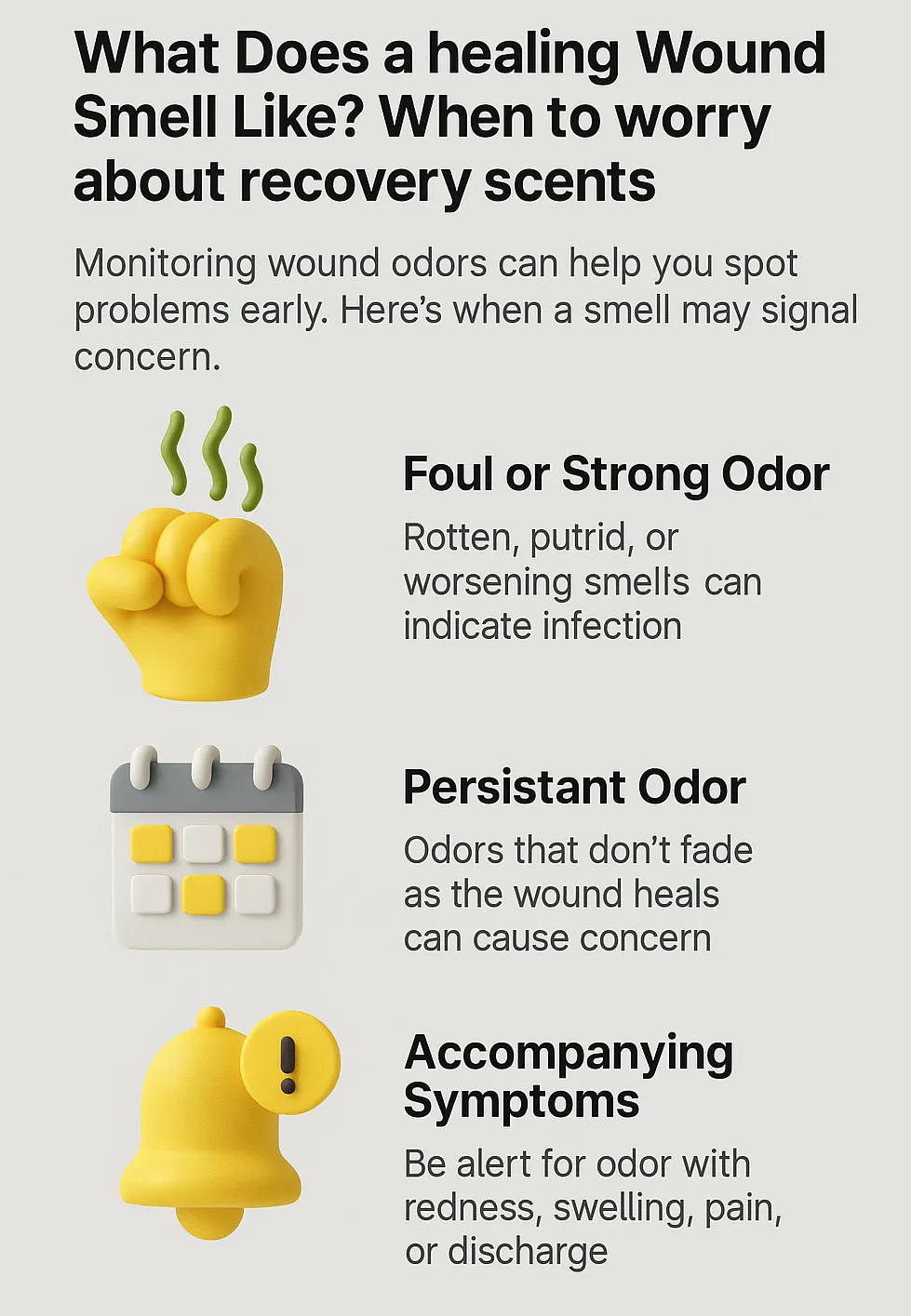If you’ve ever removed a bandage and caught a smell, you may have asked yourself: “Is this normal healing—or a signal of infection?” From clinical experience, even healthy wounds can give off subtle odors caused by moisture, dressings, or the body’s natural tissue repair. The real question is knowing when a scent is harmless and when it might be cause for concern.
This article shares first-hand wound care insights and research on what does a healing wound smell like, what healing wounds may actually smell like, how those odors change as recovery progresses, and the warning signs professionals watch for. By the end, you’ll know what scents you can safely ignore and which ones mean it’s time to call your provider.
Top Takeaways
- Mild, musty, or slightly sweet odors can be part of normal recovery.
- Strong, foul, or worsening smells often indicate infection.
- Changes in odor over time matter more than odor alone.
- Early intervention helps prevent serious complications.
Healing Wound Scents: Normal vs. Concerning
A faint odor is not unusual during healing. Mild or sweet smells often come from bandage moisture, the breakdown of old tissue, or healing fluids. These typically lessen as the wound closes.
However, when a smell grows sharp, foul, or progressively stronger, it can be one of the earliest signs of infection. If that odor appears along with swelling, redness, pus, or pain, it should be treated seriously. Professionals often rely on odor shifts as subtle—but important—indicators of complications, and recognizing these changes is a key part of practicing proper wound care.
Expert Insight
“From my experience, mild odor is usually just the body’s natural healing process. But when the scent suddenly changes or worsens—and it’s paired with swelling or pain—that’s when we become concerned about infection.”
Case Studies & Real-World Examples
Normal Recovery After Surgery
- Situation: A knee surgery wound gave off a faint, musty smell.
- Observation: No redness, pus, or swelling—just moisture trapped under the dressing.
- Action: Adjusted dressing schedule for better airflow.
- Outcome: Odor faded as the wound healed.
- Lesson: Not all odor is a warning sign.
When Odor Pointed to Infection
- Situation: A chronic foot ulcer patient noticed a sharp, foul smell.
- Observation: Odor worsened daily, accompanied by redness and pain.
- Action: Early testing, antibiotics, and wound cleaning.
- Outcome: Infection treated before it spread.
- Lesson: Worsening odor can be the body’s first alarm.
Clinical Perspective
- Studies confirm odor, paired with redness or discharge, is a reliable infection marker.
- In practice, it’s the evolution of odor—not just its presence—that tells the real story.
Supporting Statistics & Insights
- Surgical Site Infections (SSI): Over 110,000 SSIs reported annually in U.S. hospitals. CDC notes recent increases in some infection rates.
- Pressure Ulcers: Impact about 7.5% of nursing home residents, costing the healthcare system around $3.3 billion yearly.
- Diabetic Foot Ulcers: Affect 12–25% of people with diabetes over a lifetime. More than 50% become infected, and about 20% of severe cases lead to amputation.
- Amputations and Diabetes: Roughly 60% of lower-limb amputations occur in people with diabetes, with 85% preceded by a foot ulcer.
- Clinical Research on Odor: Odor is closely tied to bacterial activity, particularly anaerobes. Key markers are odor type, intensity, and progression.
Final Thought & Opinion
Mild odors often accompany healthy healing—I’ve seen this frequently in post-surgical and pressure ulcer care. But when odors intensify, turn foul, or are paired with swelling and pain, they’re a clear red flag.
My perspective:
- Use odor as a clue, not a conclusion.
- Pay attention to how the smell changes over time.
- Don’t hesitate to seek care if something feels wrong.
Bottom line: A healing wound may smell—but knowing when that scent signals danger can make all the difference in safe recovery.
Next Steps
- Check for additional symptoms: redness, swelling, warmth, drainage, or new pain.
- Keep the wound clean and protected with proper hygiene and dressings.
- Monitor odor changes: fading smells are often normal, but worsening ones need attention.
- Seek medical advice early if odors intensify or new warning signs appear.
- Trust professional evaluation for reassurance and safe recovery.
Frequently Asked Questions
Is it normal for a healing wound to smell?
Yes. Faint, musty, or sweet odors are common and often fade as healing continues.
What odor suggests infection?
A strong, foul, or worsening odor, especially with swelling or redness, may signal infection.
Can wound dressings cause odor?
Yes. Moisture trapped under bandages can create odor, even in a healing wound.
Is odor alone enough to diagnose infection?
No. Odor must be assessed alongside other symptoms like fever, pain, or drainage.
When should I see a doctor about wound odor?
Seek care if odor worsens, becomes foul, or appears with new concerning symptoms.
When exploring What Does a Healing Wound Smell Like? When to Worry About Recovery Scents, it’s helpful to think about how air quality and cleanliness also impact the healing environment. Just as wounds require clean conditions to recover safely, homes benefit from high-quality filters like Day and Night 16x25x3 Air Filters (MERV 8) that reduce airborne irritants. Professional services such as HVAC Repair Broward County FL ensure systems run efficiently, preventing the spread of bacteria or mold that could affect recovery. For everyday filter needs, accessible options like the 14x20x2 Defense 12-Pack Replacement or the 15x25x1 MERV 8 Pleated HVAC AC Furnace Air Filters offer reliable ways to keep air fresh. Even marketplaces such as eBay Filterbuy Listings provide accessible options for maintaining a healthier indoor space. Together, these solutions reflect the same principle as wound care: clean conditions reduce risk, whether for your body or your environment.





